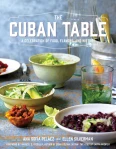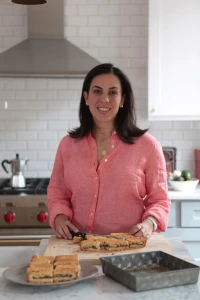Fainá a Caballo
 My oven and I have been locked in a battle of wills – and I’m losing. It will work just fine for a couple of days, do whatever I ask of it, then for no particular reason refuse to heat up at all. Its left me with unroasted tomatoes, ungratined cheese, unbaked cakes and generally frustrated. Getting anything fixed in my apartment is an ordeal and I’ve had no fewer than three visits from the building’s supers where they stand in the kitchen, look over the oven, agree that “yes, it’s not working”, then leave. While I appreciate their sympathy, the nodding isn’t getting me any closer to 350 degrees.
My oven and I have been locked in a battle of wills – and I’m losing. It will work just fine for a couple of days, do whatever I ask of it, then for no particular reason refuse to heat up at all. Its left me with unroasted tomatoes, ungratined cheese, unbaked cakes and generally frustrated. Getting anything fixed in my apartment is an ordeal and I’ve had no fewer than three visits from the building’s supers where they stand in the kitchen, look over the oven, agree that “yes, it’s not working”, then leave. While I appreciate their sympathy, the nodding isn’t getting me any closer to 350 degrees.


 Apprehensive about starting something I couldn’t finish, I’ve been sticking to the top deck – frying, stewing, and sautéeing. This week I decided to risk it and try something I’d been putting off for when Mrs. Tappan TGF320 was in a good mood. I first came across socca (also known as farinata) in an old Mark Bittman piece that resurfaced a few week ago. A kind of crêpe or flatbread, it’s made with simple batter using garbanzo flour, water and olive oil. Fresh herbs, parmesean, and sliced onions can also be tossed in. In Uruguay, where there was a large Genovese immigration, its known as fainá. Served on top of pizza, it becomes fainá a caballo or fainá on horseback.
Apprehensive about starting something I couldn’t finish, I’ve been sticking to the top deck – frying, stewing, and sautéeing. This week I decided to risk it and try something I’d been putting off for when Mrs. Tappan TGF320 was in a good mood. I first came across socca (also known as farinata) in an old Mark Bittman piece that resurfaced a few week ago. A kind of crêpe or flatbread, it’s made with simple batter using garbanzo flour, water and olive oil. Fresh herbs, parmesean, and sliced onions can also be tossed in. In Uruguay, where there was a large Genovese immigration, its known as fainá. Served on top of pizza, it becomes fainá a caballo or fainá on horseback.
Because the cast-iron skillet (for the fainá) and pizza stone are both preheated inside the oven, I’d know soon enough if it was going to cooperate before I’d committed the batter. In case it was a fail, I bought the pizza dough pre-made and figured the tomato sauce could be frozen. The batter could rest for anywhere from 2-12 hours so I could always try again later. In the end, none of that mattered because after a about 15 minutes my oven was steadily working its way up to blazing hot. Moving fast, I rolled out the pizza while the batter rested and messily added the toppings. Because it needs a few extra minutes, the batter went in first followed by the pizza. Done at about the same time, I added a drizzle of olive oil to the fainá and dropped the skillet down to the broiler to brown the top. The broiler made a half-hearted attempt at crisping but it didn’t matter too much. It had put in a good day’s work and needed a rest.
 Fainá a Caballo/Chickpea Crêpe atop Pizza
Fainá a Caballo/Chickpea Crêpe atop Pizza
In minimalist fashion, Bittman makes a resting period for the batter optional but the batch I left out at room temperature for a couple of hours came out the best. Still, he does figure out how to do it without a wood burning oven and cooper pan so keeping it simple has its merits.
Known as socca in Nice, cecina in Tuscany, farinata in most of Italy, and fainá in Genoa, Uruguay, and Argentina, it can be served atop pizza or as an appetizer. I did read that canola or sunflower oil is often used in Uruguay where olive oil can be expensive but haven’t tried. I included the recipe for the pizza I made as well but any variation would work, though a sauce heavy slice balances out the crispness of the flatbread well.
For the fainá (barely adapted from this article by Mark Bittman):
1 cup chickpea flour (also sold as garbanzo flour)
1 teaspoon sea salt
1 teaspoon freshly ground black pepper
1 cup lukewarm water
4-5 tablespoon olive oil, divided
1 tablespoon fresh rosemary leaves
Sift together the chickpea flour, salt and ground pepper. Slowly, stir in the lukewarm water, whisking constantly to eliminate lumps. Stir in 2 tablespoons of olive oil. Cover, and let sit for two hours at room temperature or refrigerate for up to 12 hours.
Preheat the oven to 450 degrees and place a well-seasoned cast-iron skillet inside.
Stir the rosemary into the batter. Carefully remove skillet from oven and pour 2 tablespoons of olive oil into the heated pan, swirling to cover the pan. Pour in the batter and place in oven. Bake for 12 to 15 minutes, until it’s firm and the edges are set. If it looks dry, brush lightly with olive oil and place under the broiler to lightly brown the top. Watch carefully.
Sprinkle with salt or pepper. Cut and serve on its own or toss it on some pizza.
For the pizza:
1/2 pound thawed, frozen pizza dough, divided and formed into a ball
3 tablespoons olive oil, extra virgin
1 medium yellow onion, diced
3 garlic cloves, peeled
1 teaspoon sea salt
¼ teaspoon freshly ground pepper
1 pound ripe tomatoes, cut in half horizontally
8 ounces fresh mozzarella, sliced
¼ cup parmesan or manchego cheese, shredded
1 tablespoon fresh oregano, chopped
Shape the dough into a ball and allow to sit at room temperature at least 20 minutes or up to an hour before shaping.
While the dough rests, prepare the tomato sauce. Heat the oil in a large skillet over medium heat until shimmering. Add the onions and cook until golden, about 15 minutes. Using the side of a large knife or mortar and pestle, mash the garlic to a paste and combine well with salt and pepper. Add to the skillet and sauté and additional 2-3 minutes, stirring constantly. Pass the cut tomatoes through a box grater, reserving pulp and juice and discarding the skin. Stir in the tomato pulp.
Bring to a simmer then turn the heat to medium-low. Cook, partially covered, stirring occasionally, about 30 minutes. Season with additional salt and pepper to taste. Use immediately or puree until smooth. Makes about 1 ½-2 cups.
Roll out the dough on a lightly floured surface to a 10-12-inch circle. To stretch the dough, hold the dough between the palm and fingers and gently press the edges while you pull it counter-clockwise, to form an oval. Place the dough on the peel and cover with 5 or 6 slices of mozzarella. Spoon the tomato sauce on top, leaving a border, and sprinkle with shredded cheese.
Position the peel at the far edge of the baking stone and, in one smooth motion, slide it toward you, leaving the pizza on the stone. Bake until the edges are golden brown and the cheese is bubbling, 8-10 minutes. Transfer to a wire cooling rack, sprinkle with oregano, and wait several minutes before slicing.







Despite the issues you and your oven have, the dish came out wonderfully perfect. I can only imagine how good it must taste. Best of luck!
Your oven situation sucks! That faina looks very delicious – lovely photos.
Thank you! I was able to bake cookies this weeks so that’s progress:)
Looks fantastic! I’m such a fan of the Minimalist – love chickpea flour too. Hope your kitchen cooperates from now on!
This looks pretty darn delicious. Love the combination of flavors you have going here.
Looks amazing. Can’t wait to try it.
Hungry Sofia — Good blog, good photos. How can I use one of your photos for a blog or book?
Email me directly and thank you for your interest.
How do I email you directly? Please provide address.